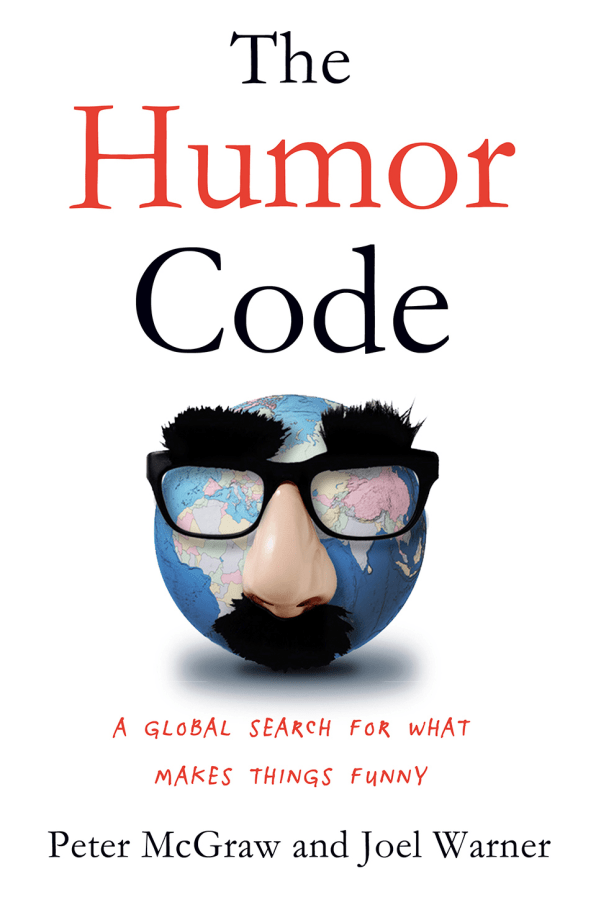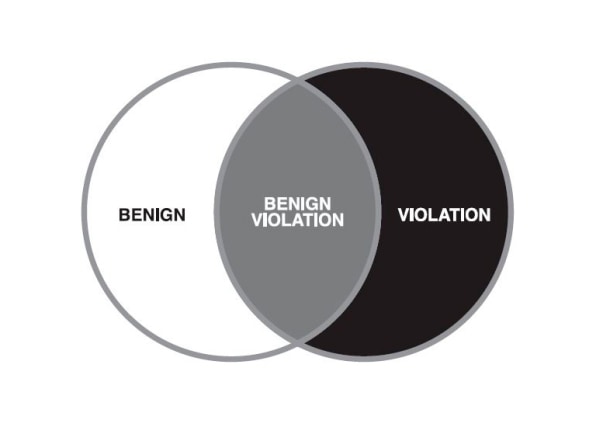I Dont Want to Be the Funny Person Anymore
Making people laugh is not rocket science. Information technology is (a kind of) science, though.

Anyone who'due south ever wondered precisely why their joke did not land has a patron saint in professor Peter McGraw, who has plumbed the depths of human behavior to determine what is funny and what is not. Along with co-writer Joel Warner, McGraw has explored comedy all over the world, from the sets of Tokyo's bizarre game shows to Palestine's version of Sat Nighttime Live, and beyond. This exploration has resulted in a book called The Sense of humour Lawmaking, and a reasonable scientific explanation for why people express mirth at certain things and not others.
"Humor arises when something seems wrong, unsettling, or threatening (a kind of violation), but simultaneously seems okay, acceptable, or safe," McGraw says. This idea makes up his Benign Violation theory, and it serves as the engine driving the volume. "A dirty joke trades on moral or social violations, but it'due south but going to get a express joy if the person listening is liberated plenty to consider risqué subjects okay." He adds, "Even tickling, which has long been a sticking point for other sense of humour theories, fits perfectly. Tickling involves violating someone's concrete space in a benign fashion. You lot tin can't tickle yourself because it isn't a violation. Nor volition yous laugh if a creepy stranger tries to tickle y'all, since nothing about that is beneficial."

For his office, Warner posits a much simpler explanation virtually what makes something funny: farts. (Not all theories require heavy bookish enquiry.) The co-author commencement became interested in humor every bit a topic in 2010, when he defenseless wind of McGraw's academically-sanctioned Humor Research Lab (affectionately nicknamed Bung). The professor had been at information technology for years, obsessed with uncovering why an chestnut he'd mentioned in a oral communication at Tulane fetched unlikely laughs from the oversupply. One time Warner observed one of McGraw'southward experiment in which participants watch Hot Tub Time Machine while sitting at various locations in a room, he saw a story in McGraw's quest to find out, on a scientific level, what makes things express joy-worthy. The two soon joined forces.
McGraw developed his benign violation concept by modifying and expanding on an earlier linguist'south theory, one whose definitions didn't seem to embrace the right bases. The professor has been conducting rigorous scientific testing at HuRL and in his travels with Warner ever since, and thus far the concept has held water. Unlike other sense of humor theories, such as superiority theory, incongruity theory, and relief theory, benign violation offers more explanations for why some things aren't funny.

"A joke can fail in ane of 2 ways," he says. "It can be too benign, and therefore boring, or it tin be likewise much of a violation, and therefore offensive."
The only way for people who want to be funny, peradventure professionally, to know the difference is to approach their humour the manner McGraw and Warner have: similar scientists.

"It might not seem similar it, but the best comedians hone their material scientifically, by experimenting bit by bit," says Warner. "And the but mode to acquire is through hard, repetitive, empirical piece of work. You lot get up there on that phase night after nighttime, estimate which lines piece of work and which don't, and adjust accordingly."
And if that doesn't work, well, at that place'southward always the farting pick.
Below, read through McGraw and Warner's explanations for whether a sampling of stand-upwardly, movie, and sketch clips are funny.
#ane) Dumb & Dumber, peppers scene
We don't find this sort of gross slapstick peculiarly hilarious. (We, like all astute comedy aficionados, prefer to chuckle modestly at New Yorker cartoons while drinking cognac.) However, nosotros will admit that broad, physical, and yes, stupid comedy similar this has a pretty practiced shot at existence funny all over the world.
Accept the work of British psychology professor Richard Wiseman. In 2001, Wiseman set out to find the world's funnies joke. Over twelve months, his "LaughLab" website clocked twoscore,000 joke submissions and almost two million ratings from people in 40 different countries–the largest-ever scientific humor study. According to the results, this was the funniest joke:
"Two hunters are out in the woods when one of them collapses. He doesn't seem to be breathing and his eyes are glazed. The other guy whips out his telephone and calls emergency services. He gasps, 'My friend is expressionless! What can I practise?' The operator says, 'Calm down. I can help. First, let's make sure he's dead.' At that place is a silence, then a gun shot. Back on the telephone, the guy says, "Okay, now what?'"
We met Wiseman in London, and he had aught skillful to say about this zinger. "I remember the world's funniest joke isn't very funny," he grumbled. "It's terrible. I think we institute the world's cleanest, blandest, almost internationally accustomed joke. It'due south the color beige in joke form."
This makes sense. Universal one-act isn't going to be the stuff that the nearly people find hilarious, information technology'south going to exist the stuff that the least number of people find offensive. Whatsoever joke that makes fun of a detail people, organized religion, occupation, or viewpoint isn't going to fly. Information technology has to be something that'due south acceptable to everybody–or in other words, something that'south a chip stupid. And Dumb and Dumber is as stupid as it gets.
#2) Tig Notaro's Taylor Dayne story
According to Pete's benign violation theory, people can apply 1 of two strategies to improve their shtick: they tin can make upsetting concepts more agreeable by making them seem more benign (aka the Sarah Silverman Strategy, later the comedian who gets abroad with jokes on abortion and AIDS because the manner she tells them is so darn cute), or they tin signal out what is hilariously wrong with our benign, everyday concepts (aka the Seinfeld Strategy: "What's up with that plane food?"). Tig Notaro is incredibly skilled in the Seinfeld Strategy, pointing out the applesauce in the stuff that about people take for granted.
Here, she even uses the strategy to point out the applesauce of her own routine: I've forgotten what to say next, and nonetheless withal you lot people are laughing! Why would I make upwards a story about a vocaliser none of you have heard of, that doesn't even have a good punch line! Plus, Tig Notaro is magical. She makes everything funny. Have y'all seen the bit where she does nothing but push a stool across a stage, and all the same yet the audience is loving it? In that case, fine art trumps science.
#three) Primal & Peele's Eastward-West Bowl sketch
Wait, you want two geeky white guys to explain what makes a Key and Peele sketch involving convoluted African-American names funny? Fat chance. That, according to science, would exist a pure violation. Please get us a grad student to effigy it out for united states.
Source: https://www.fastcompany.com/3028499/this-is-why-youre-not-funny-a-professors-scientific-approach-to-dissecting-humor
0 Response to "I Dont Want to Be the Funny Person Anymore"
Enregistrer un commentaire